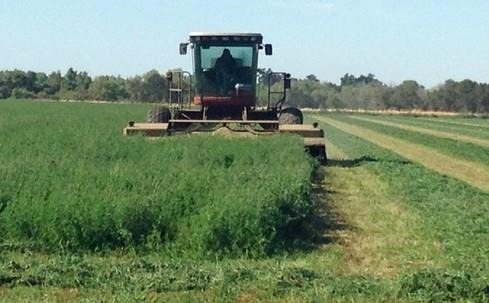By Pamela Kan-Rice

A new UC cost study shows potential profits in growing alfalfa organically for the organic dairy market.
A new study that outlines costs and returns of establishing and producing organic alfalfa hay has been released by UC Cooperative Extension, the UC Agricultural Issues Center and the UC Davis Department of Agricultural and Resource Economics.
High-quality organic alfalfa hay is an important ingredient in milk-cow feed rations for organic dairies. Organic dairy farms are required to use organic feed and allow cows to graze for part of their forage. Organic alfalfa hay comprises a major source of forage for the industry.
In 2019, organic dairy farms in California produced about 900 million pounds of milk — just over 2% of California milk output production, according to co-author Daniel Sumner, director of the UC Agricultural Issues Center and professor in the UC Davis Department of Agricultural and Resource Economics.
“Demand for organic alfalfa production has grown, including demand from dairy, horse, sheep, goat, and beef producers, but is still a small share of total alfalfa production,” said Daniel Putnam, UC Cooperative Extension forage specialist in the Department of Plant Sciences at UC Davis and co-author of the study. “However, understanding organic production methods and costs is very important for California's organic hay farmers.”
The new study estimates the costs and returns of establishing and producing organic alfalfa using flood irrigation in the Sacramento Valley, north and south San Joaquin Valley, and the Intermountain Region. The 100 acres of organic alfalfa is rented for $345 per acre annually and the alfalfa stand life is four years after the establishment year.
Input and reviews were provided by UCCE farm advisors and specialists and growers. The authors describe the assumptions used to identify current costs for organic alfalfa establishment and production, material inputs, cash and non-cash overhead and a ranging analysis table, which shows profits over a range of prices and yields.
“This cost study provides information on how to grow alfalfa hay organically,” said Rachael Long, study co-author and UC Cooperative Extension farm advisor in Yolo County. “The research that went into developing these practices represents a significant investment by UCCE farm advisors and specialists and California alfalfa farmer collaborators. We are pleased to team up with economics and cost study experts to provide this study, which indicates potential profits in growing this crop for the organic dairy market.”
Source : ucanr.edu